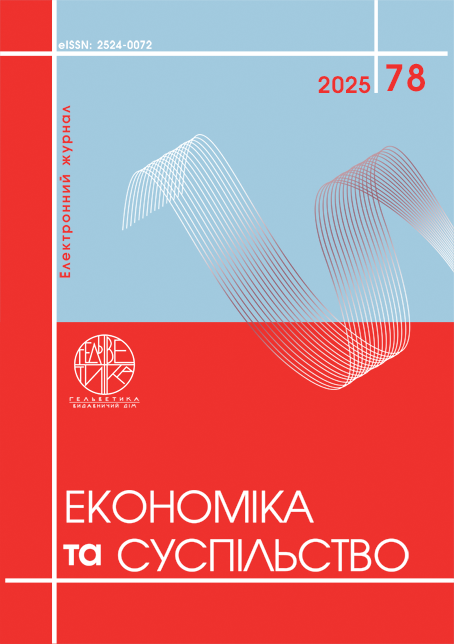DIGITAL TWINS TECHNOLOGY AS A TOOL FOR OVERCOMING WORKFORCE DEFICITS AND MODERNIZING UKRAINE’S FOOD PRODUCTION SECTOR
Abstract
This article addresses the pressing issue of labor shortages in Ukrainian food production enterprises under the conditions of war and continuous social and economic instability. The relevance of the topic is grounded in the critical importance of uninterrupted production for ensuring national food security and maintaining resilience of supply chains. The main objective of the study is to assess the potential of digital twin technology as an innovative solution capable of compensating for the lack of staff by reconfiguring production processes and enabling more sustainable operations. The methodology is based on a comprehensive analytical approach that includes conceptual analysis of the digital twin phenomenon, evaluation of its functional capabilities, as well as extrapolation of practical applications from industrial contexts to the specific environment of the food industry. The study highlights several key results. Firstly, digital twins make it possible to substitute the physical presence of staff with remote monitoring and data-driven decision-making. Secondly, predictive maintenance supported by virtual models reduces the need for extensive repair teams and lowers risks of unexpected downtime. Thirdly, automated quality control based on digital twins ensures adherence to strict standards while reducing reliance on manual labor. Finally, the creation of immersive training environments on the basis of digital replicas accelerates the integration of new employees and mitigates the impact of staff turnover. The practical value of the article lies in the formulation of recommendations for gradual adaptation of digital twin solutions to the Ukrainian food production sector. The proposed steps include pilot projects on selected enterprises, evaluation of return on investment, and the development of integration roadmaps with existing resource planning systems. The findings demonstrate that digital twins should not only be considered as a technological innovation but also as a strategic instrument for rebuilding and modernizing the agri-food sector of Ukraine. This technology has the potential to strengthen the competitiveness of Ukrainian enterprises and ensure sustainable development in a post-war economy.
References
Яковенко Ю., Шаптала Р. Цифрові двійники в українській промисловості: оптимізація ресурсів, енергоефективність та сталий розвиток. Technology Audit and Production Reserves. 2024. 2(4(76), С. 11–20.
Панкратова Н., Сидоренко А., Власенко О. Концепція цифрового двійника: етапи розвитку, класифікація та галузі застосування. IASA Journal. 2023. № 4. С. 12–27.
Веретельник В., Латишева Т., Кубявка Л. Планування проєктно-виробничої діяльності з використанням цифрового двійника. Eastern-European Journal of Enterprise Technologies. 2024. № 5(3 (131). С. 6–17.
Притьков Н. І., Заморєв А. С. Бар’єри впровадження цифрових двійників: технічні, організаційні та економічні чинники. Philosophical Problems of IT and Cyberspace (PhilIT&C). 2023. № 1. С. 53-64.
Хан М., Чжоу Л., Пател Р. PerfCam: цифровий двійник для моніторингу виробничих ліній на основі камерного аналізу OEE. arXiv. 2025. № 2502. С. 1–15.
Двуліт З., Мазник Л., Мазник К., Брич Л., Двуліт М.-М., Іващук Н., Іващук А. Використання технології цифрових двійників (DT) для прогнозування потреб у робочій силі в післявоєнній реконструкції України // 2nd International Conference on Smart Automation & Robotics for Future Industry (SMARTINDUSTRY – 2025), Lviv, Ukraine. CEUR Workshop Proceedings. 2025. № 3678. С. 112–124.
Тао Ф., Чжан Х., Ліу А., Ні А. Цифрові двійники в промисловості: сучасний стан і напрями майбутніх досліджень. Advanced Engineering Informatics. 2022. Т. 52. С. 101554. DOI: https://doi.org/10.1016/j.aei.2022.101554
Негрі Е., Фумагаллі Л., Маккі М. Огляд ролей цифрових двійників у розумному виробництві. Computers in Industry. 2021. Т. 132. С. 103476. DOI: https://doi.org/10.1016/j.compind.2021.103476
Шубенкова К., Петров А. Цифрова трансформація харчової промисловості: впровадження цифрових двійників для сталого виробництва. Journal of Food Systems and Digital Innovation. 2024. Т. 8, № 2. С. 67–79.
Габор Т., Белцнер Л., Кірмаєр М., Фам М. Архітектура цифрових двійників для розумного виробництва, заснована на моделюванні. IEEE Access. 2023. Т. 11. С. 45621–45635. DOI: https://doi.org/10.1109/ACCESS.2023.3245781
Yakovenko, Y., & Shaptala, R. Tsifrovi dviinyky v ukrainskii promyslovosti: optymizatsiia resursiv, enerhoefektyvnist ta stalyi rozvytok. [Study of digital twins as the driving force of digital transformation and achieving the goals of sustainable development]. Technology Audit and Production Reserves, 2(4(76), 11–20.
Pankratova, N., Sydorenko, A., & Vlasenko, O. (2023) Kontseptsiia tsyfrovoho dviinyka: etapy rozvytku, klasyfikatsiia ta haluzi zastosuvannia. [Digital twins: stages of concept development, areas of use, prospects]. IASA Journal, (4), 12–27.
Veretelnyk, V., Latysheva, T., & Kubiavka, L. (2024) Planuvannia proiektno-vyrobnychoi diialnosti z vykorystanniam tsyfrovoho dviinyka. [Development of a concept of combined project-production activities planning using digital twins]. Eastern-European Journal of Enterprise Technologies, 5(3 (131), 6–17.
Prytkov, N. I., & Zamorev, A. S. (2023). Bar’yery vprovadzhennia tsyfrovykh dviinykiv: tekhnichni, orhanizatsiini ta ekonomichni chynnyky. [Barriers to the integration of digital twin technology in manufacturing] Philosophical Problems of IT and Cyberspace (PhilIT&C), 1:53-64.
Khan, M., Zhou, L., & Patel, R. (2025). PerfCam: PerfCam: Digital Twinning for Production Lines Using 3D Gaussian Splatting and Vision Models. arXiv, 2502, 1–15.
Dvulit, Z., Maznyk, L., Maznyk, K., Brych, L., Dvulit, M.-M., Iwaszczuk, N., & Iwaszczuk, A. (2025) Using Digital Twin (DT) Technology for Workforce Demand Forecasting in the Post-War Reconstruction of Ukraine. In 2nd International Conference on Smart Automation & Robotics for Future Industry (SMARTINDUSTRY – 2025), Lviv, Ukraine. CEUR Workshop Proceedings, 3678, 112–124.
Tao, F., Zhang, H., Liu, A., & Nee, A. (2022) Digital Twin in Industry: State-of-the-Art and Future Research Directions. Advanced Engineering Informatics, 52, 101554. DOI: https://doi.org/10.1016/j.aei.2022.101554
Negri, E., Fumagalli, L., & Macchi, M. (2021) A Review of the Roles of Digital Twin in Smart Manufacturing. Computers in Industry, 132, 103476. DOI: https://doi.org/10.1016/j.compind.2021.103476
Shubenkova, K., & Petrov, A. (2024) Digital Transformation of the Food Industry: Implementation of Digital Twins for Sustainable Production. Journal of Food Systems and Digital Innovation, 8(2), 67–79.
Gabor, T., Belzner, L., Kiermeier, M., & Pham, M. (2023) A Simulation-Based Architecture for Smart Manufacturing Digital Twins. IEEE Access, 11, 45621–45635. DOI: https://doi.org/10.1109/ACCESS.2023.3245781

This work is licensed under a Creative Commons Attribution 4.0 International License.


